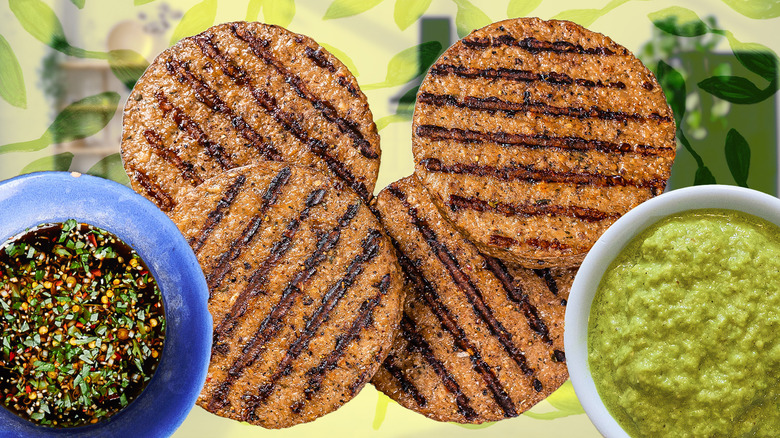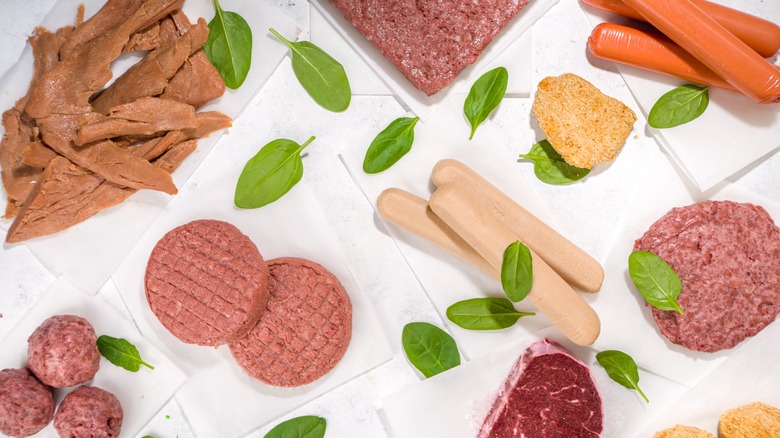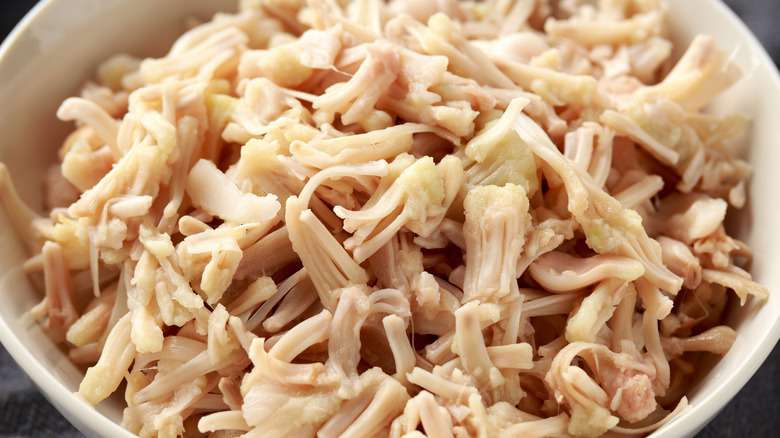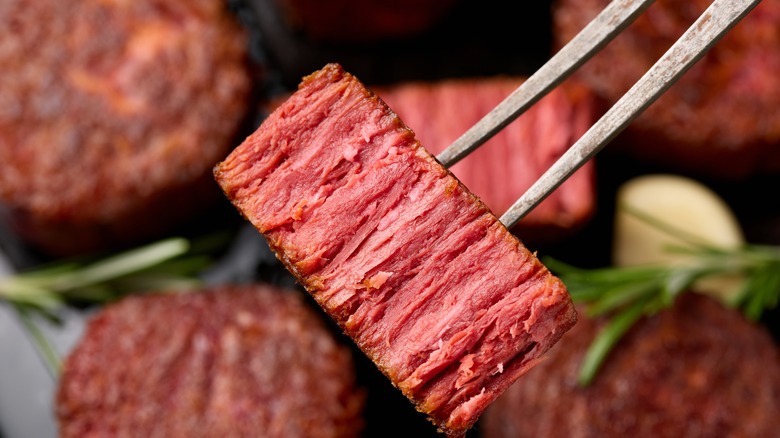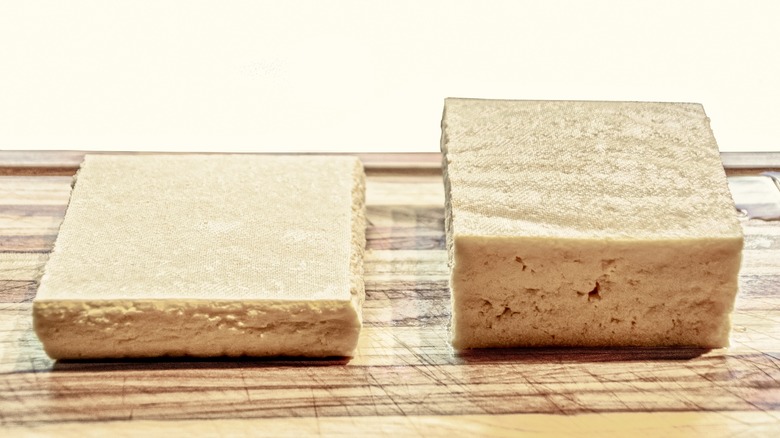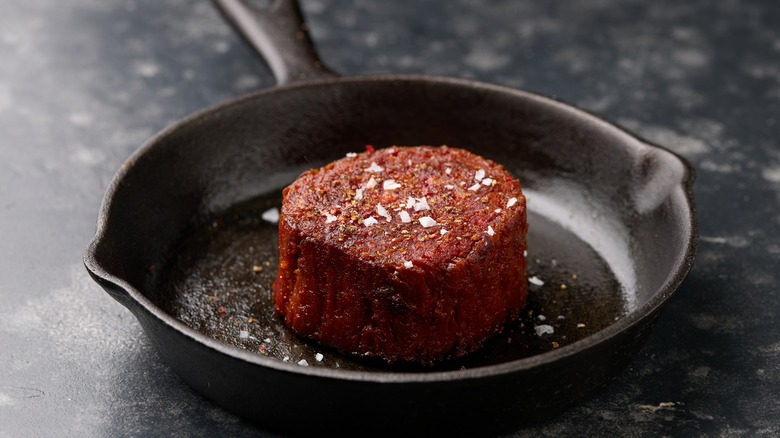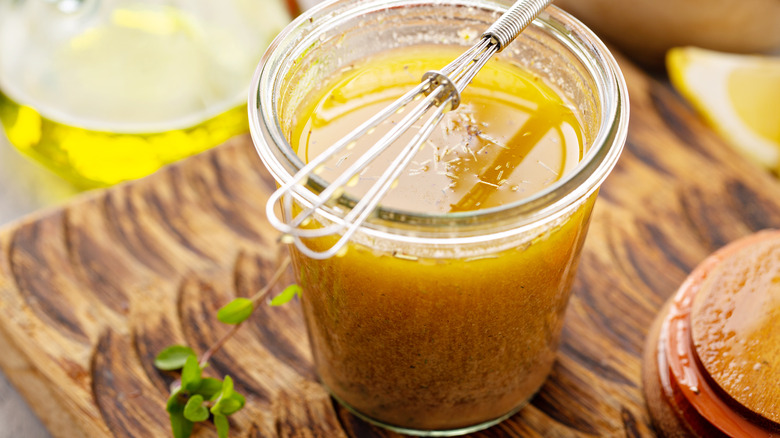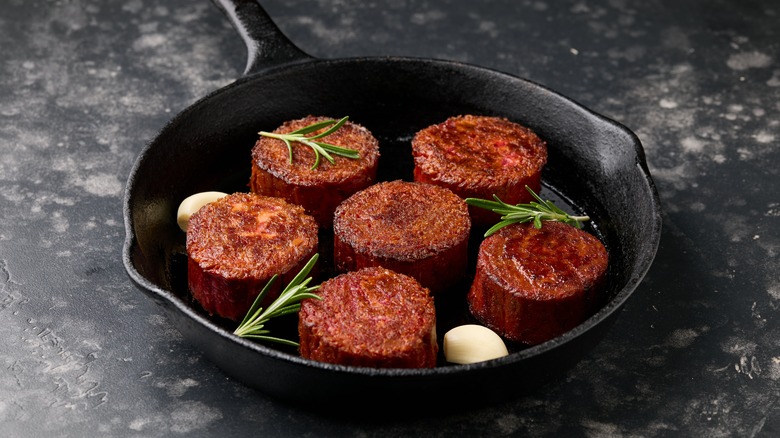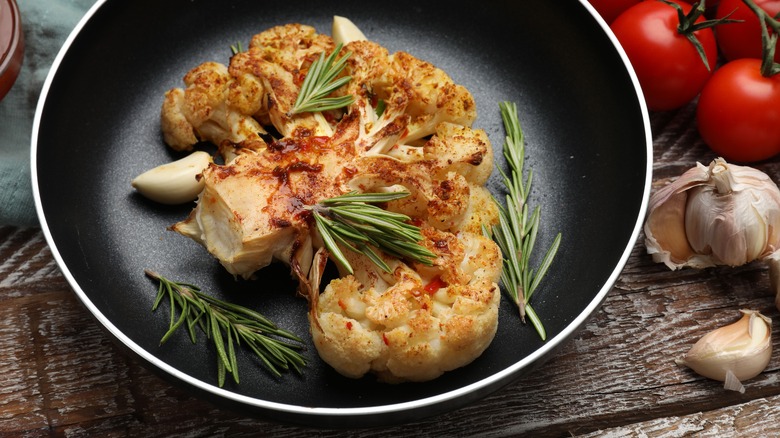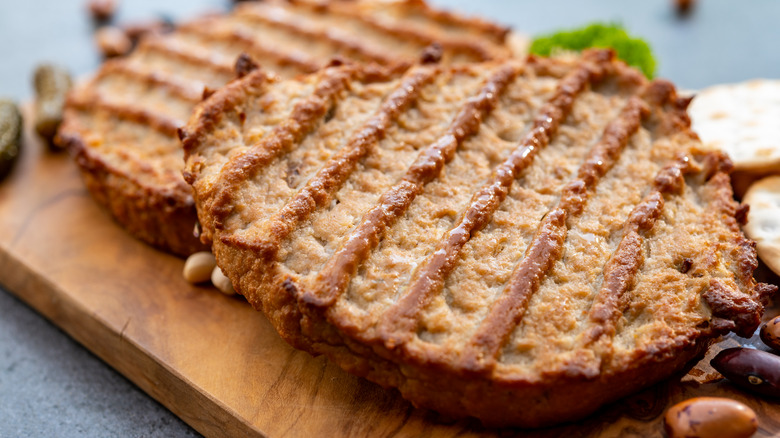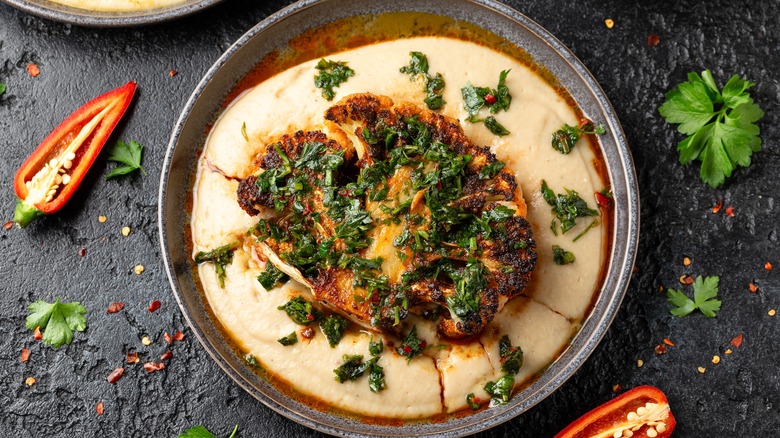10 Pro Tricks For Cooking The Perfect Plant-Based Steak
We may receive a commission on purchases made from links.
It's fair to say that the unfavorable reputation of blandness that was once unjustly afforded to plant-based meat alternatives has mostly been left in the past. As vegan diets and plant-based cooking have continued to rise in popularity in recent years, so too has the art of crafting delicious plant-based steaks, with creative ingredients and innovative techniques coming together to create truly impressive results that rival any traditional meat steaks. But it's not just about mimicking meat, either. Much of the practice of creating a great plant-based steak comes from celebrating the unique flavors that come from hearty, earthy vegetables, as well as the ideal textures of firm plant proteins such as tofu that offer a substantial and satisfying bite.
However, although plant-based steaks are generally incredibly versatile, it can be a little tricky to know how to work with certain ingredients to produce a successful steak. There is considerable variation between not only meat and plant-based alternatives, but also between substitutes themselves. This can make securing success a bit difficult at times, especially if you're using an ingredient or a cooking technique that you're not all that used to.
For expert advice on how to ensure optimal outcomes every time, we spoke to Iosune Robles, vegan recipe developer and cook behind Simple Vegan Blog. Robles' valuable insights, on everything from selecting the right ingredient to achieving a perfectly crisp exterior, will provide you with everything you need to know about cooking a plant-based steak for guaranteed great results.
1. Choose the right plant-based steak substitute
When it comes to ensuring a perfect vegan steak, the first crucial step is to select a suitable plant-based meat substitute. There are a multitude of vegetables, fruits, and other plant-based proteins that can be transformed into steaks, but there's no doubt that certain ingredients are better suited to the job than others, especially when it comes to securing that chewy, "meaty" texture that you're likely aiming for. You'll want to opt for something that not only has the structure to hold up to cooking methods like grilling or pan-searing, but also that crucially still delivers both tasty flavor and a satisfying bite.
As Iosune Robles notes, seitan serves as a strong choice, adding that its firm and chewy texture make it perfect for steak, as it closely mimics the mouthfeel of a conventional beef steak. Extra firm tofu is also one of Robles' go-tos, thanks to its similar sturdy texture, alongside portobello mushrooms, which she notes soak up marinades and moisture notably well for a flavorful and tender "meaty" bite.
Tempeh, cauliflower, and eggplant also offer themselves as perfectly suitable options, with each lending their own unique flavor and texture for something a little different. As Robles points out, eggplant, for example, is a little softer than most other popular options, but nonetheless remains an excellent choice if you're after something a little more tender and are not too concerned about the density of your steak. So, opt for an ingredient that best suits your needs.
2. Combine ingredients for additional layers
A solid base is no doubt at the heart of ensuring a perfect vegan steak, but combining this base with extra ingredients is an incredibly simple but excellent way to ensure even more delicious results. Indeed, combining different plant-based ingredients is a great means of adding layers and extra dimension to your steak, providing it with more nuance and a sense of variety that makes for an overall more exciting bite with a dynamic texture. As Iosune Robles tells us, mushrooms and shredded jackfruit lend themselves well to this purpose, contributing their tasty and tender properties when incorporated into the mix.
Thanks to its consistency, which is reminiscent of pulled pork and shredded chicken, jackfruit has established somewhat of a reputation when it comes to replicating the taste and texture of meat-based dishes — with its ability to soak up marinades and seasonings further validating its usefulness as a plant-based substitute. When combined with firm ingredients like tofu or seitan, shredded jackfruit adds an irresistible depth that completely transforms the composition of a vegan steak, making each mouthful feel a little different.
Likewise, finely chopped mushrooms, such as shiitake, contribute an additional layer of chewiness for a texture that closely resembles the density of a meat-based steak whilst still remaining tender. The addition of mushrooms may also contribute to the overall flavor of the steak too, delivering an extra umami kick for added richness and a more substantial, satisfying feel.
3. Match your cooking technique to your vegan steak
Not only is selecting the right ingredient(s) to use for your vegan steak important, but choosing the appropriate cooking method is also crucial for ensuring success. Some ingredients hold up better than others under certain cooking conditions, and specific methods of cooking can help a particular plant-based steak to shine where it might elsewhere fall a little flat.
For example, firm options like seitan, tofu, and tempeh tend to fare well when prepared with an array of cooking methods. They're able to handle high heat without falling apart and require less time to cook all the way through than thickly cut portions of other vegetables. Indeed, if you're cooking with other plant-based options such as cauliflower, eggplant, or cabbage, you'll want to keep their texture and moisture content in mind and match your cooking technique accordingly.
The more delicate texture of eggplant means that it is best prepared grilled or roasted, with the latter helping to provide a slightly firmer texture and reduce the risk of the steak becoming too soggy or mushy. Likewise, cauliflower, which delivers the best steak experience when sliced into thick, hearty slices, is best prepared roasted. The slower, more gentle heat from the oven ensures that it cooks evenly all the way through without burning on the outside.
4. Invest in a tofu press
If you're looking to make a perfect vegan steak using tofu, then a tofu press should be considered a crucial investment. Tofu naturally holds a lot of water, and neglecting to press it before cooking can result in a soggy, mushy texture that is far removed from the tender but robust consistency that you're no doubt aiming for. If enough water is not removed, the tofu may also fall apart entirely, especially when being fried.
As such, Iosune Robles recommends including this step in your preparation, confirming that "pressing tofu helps make it denser," and noting that not doing so is a common cause of textural issues. You'll want to press your tofu even if the kind you are using is already of the extra firm variety, since even those labelled as such can still hold a significant amount of water that may jeopardize the consistency of your steak. Plus, pressing your tofu isn't only crucial for obtaining the perfect sturdy texture, but also helps ensure better flavor. When you draw the moisture out of the tofu, you allow for marinades to penetrate deeper and remain concentrated, resulting in an overall better-tasting steak with a more intense flavor. So, your steak is sure to be better all-around with the inclusion of this simple step.
If you don't have a tofu press, you can squeeze the moisture out using something like a heavy-based pan, but it's no doubt easier (and less messy) to buy a tofu press. A couple popular, highly-ranked options on Amazon include the NOYA Adjustable Tofu Press for $25.99 or the Tofuture Tofu Press for a bit less at $21.99.
5. Pan-sear or grill your plant-based steak for a crispy exterior
Arguably a key part of achieving a perfect plant-based steak is obtaining that ideal combination of a juicy and tender inside and a beautifully charred, lightly crisp outside. A flavorful crust makes both the taste and texture of your steak all the more enjoyable, thanks to the satisfying contrast it delivers.
Whilst certain meat substitutes will, as Iosune Robles clarifies, require specific methods based on their unique properties, she confirms that pan-searing or grilling where possible are the best ways to achieve this gloriously crackling, lightly caramelized outer coating and inviting crispy edges. She adds that both methods also do a great job of making sure the inside of the steak stays juicy — so, if you're using tofu, tempeh, seitan, or an ingredient with a similar density and level of moisture, you'll almost certainly want to cook them in one of these two ways.
An important part of nailing these methods, and subsequently securing a perfectly browned and crunchy exterior, is ensuring that things are nice and hot before you start. When using a pan, give your oil or cooking fat plenty of time to heat up before you add your steaks to allow them to develop this sear without overcooking the inside. Likewise, if you're cooking multiple steaks, focus on searing them one or two at a time. Overcrowding your pan will make it harder for each steak to crisp up properly, and it may lead to uneven cooking or a lackluster texture.
6. Don't skip the marinade
Iosune Robles explains, "For a good plant-based steak, marinades and seasonings make all the difference." So, it's not something you'll want to overlook. Indeed, though they lend themselves well to the purpose of making a tasty steak, ingredients like seitan and tofu are somewhat lacking the inherent depth of flavor that is found in meat — meaning that a well-chosen marinade is necessary for creating the rich, savory, and nuanced flavors you are after. Meanwhile, ingredients like portobello mushrooms (which, as mentioned, are an excellent candidate when it comes to choosing a base, thanks to their somewhat meaty texture and excellent ability to soak up marinades), do boast a natural earthy and umami flavor. But they nonetheless benefit from a little extra kick to truly make them shine.
"If you're using seitan or tofu, marinades with soy sauce, garlic, smoked paprika, and a splash of liquid smoke can really give them that deep, savory flavor," says Robles. These umami-rich and bold ingredients ensure depth and a beautiful, cured flavor that does well to replicate the nuance of a conventional beef steak. Tempeh, meanwhile, works particularly well alongside equally bold but more tangy flavors. Robles suggests marinades made with balsamic vinegar, mustard, and maple syrup for a touch of sweetness and a well-balanced profile.
For vegetables like cauliflower, eggplant, and mushrooms, it's best to lean into their natural flavors and elevate existing tasting notes. "Mushrooms always pair well with earthy seasonings," Robles adds, recommending garlic and thyme, in particular.
7. Avoid overcooking your vegan steak
One of the biggest mistakes you can make when cooking a plant-based steak is overcooking your ingredients. Though a lot of plant-based ingredients do not dry out in the same way as meat, they can still, Iosune Robles confirms, become dry and tough if cooked for too long or too intensely, resulting in a less-than-ideal texture and disappointing, bland flavor.
To avoid this, keep an eye on your ingredients and pay attention to visual cues like the texture. This goes for both steaks that you are searing on the stovetop and those that you are roasting in the oven. Spongy and delicate vegetables can become mushy when left in the oven for too long, so be sure to check at frequent intervals, pricking with a skewer or knife to check their tenderness.
It can, of course, be tricky to know the exact timings you need, especially if it's your first time cooking with a certain ingredient. Other variables, such as how thick your steaks are, or whether you have mixed them with additional ingredients, can also have an impact on how long they need to be cooked for. The best practice is to top up marinades if things start to look dry, and to also keep the heat at a moderate level. Though a high heat is ideal for achieving a crispy exterior, you don't want your steaks sizzling in an excessively hot pan for too long — so, reduce the heat once you've seared the steaks on both sides.
8. Sear before baking
As established, for the best results, it's important to select a cooking method that works for a given ingredient. Cauliflower steaks often provide excellent results with a satisfying bite, but their thick, firm texture means that pan-searing them from start to finish as a means of cooking them is pretty much a no-go. By the time the inside is cooked enough to the point that the steak is tender, the outside will likely be very charred and bordering on burnt, not to mention likely very dry and slightly bitter.
But what about securing the delicious crispy crust that takes a steak from good to great? You don't have to accept that this is unattainable if your chosen ingredient is going to spend the majority of its time in the oven. A combination of cooking methods provides the ideal solution to achieving this sought-after textural contrast, whilst also preventing your steak from either drying out or remaining undercooked.
Before you pop your vegetables in the oven to roast, simply give them a quick flash on each side in a hot pan, watching to make sure that the exterior develops a nice golden-brown char without burning. As they continue to cook in the oven at a gentle, gradual heat, the insides will cook to perfection whilst the exterior crisps up a little more. This will give you the same balance of crunchy and tender that you would expect to find from entirely pan-fried alternatives.
9. Rest your steak after cooking
Although resting is a widely known important step when it comes to cooking meat, it's a culinary practice that is sometimes overlooked when it comes to preparing plant-based meals. But resting is by no means exclusive to meat, and Iosune Robles assures us that it's a crucial step in securing a perfectly juicy vegan steak. "Resting is key because it lets the juices redistribute throughout the plant-based steak, making it more tender and flavorful," she says, adding that cutting into the steak prematurely causes these juices to run out, which makes the steak become dry.
Regardless of what your steak is made from, it will no doubt benefit from a few minutes off the heat, whereby moisture is locked in, flavors intensify, and softer vegetables may also firm up slightly for a more satisfying bite. After spending the time and effort to ensure your plant-based steak is as moist and flavorsome as can be, it's no doubt worth taking a little extra time to let things settle for a short while after cooking — lest the consideration you've put in thus far be in vain.
10. Pair your plant-based steak with worthy accompaniments
One of the best ways to elevate a plant-based steak is to pair it with the right accompaniments. Even the most perfectly executed steaks can benefit from an added boost in the form of a flavorful sauce or a comforting side dish — both of which may not only heighten the taste and texture of the steak itself but also ensure a cohesive, satisfying, and inviting meal.
Iosune Robles recommends roasted vegetables, whose earthy taste and tender bite, as well as possible caramelized edges, beautifully complement the tenderness and woodiness of a plant-based steak. Likewise, creamy vegan mashed potatoes make for a hearty and comforting side dish for that ultimate indulgent feel, whilst fresh salads can be useful if you're looking for a side that will cut through some of the richness or saltiness of your steak.
"For sauces, chimichurri, vegan peppercorn sauce, or a rich vegan mushroom gravy can really bring out the flavors," says Robles. Chimichurri provides a fresh, vibrant, and herbaceous kick with a slightly tangy undertone on account of the red wine vinegar in it. Meanwhile, a rich, salty gravy can be equally as delicious, heightening pre-existing woody, earthy flavors to produce a dish that feels truly luxurious. For something a little different, teriyaki sauce or a sweet and smoky barbecue sauce can add a whole new dimension. So, feel free to use whatever you have on hand and adapt your steak by working with specific flavors and sides.
